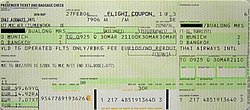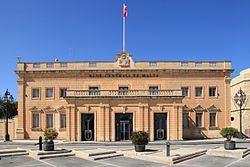Search results
Appearance
There is a page named "Maltese lira" on Wikipedia
- The lira (Maltese: lira Maltija, plural: liri, ISO 4217 code: MTL) or pound (until ca. 1986 in English, code MTP) was the currency of Malta from 1972...20 KB (1,435 words) - 21:10, 2 December 2024
- the Italian lira Maltese lira 1825–2007; merged into the euro, 2008 Neapolitan lira 1812–1813; merged into the Italian lira Ottoman lira 1844–1923; became...9 KB (895 words) - 19:07, 25 October 2024
- Union of the European Union. Malta adopted the euro as its official currency on 1 January 2008, replacing the Maltese lira. For a period of one month until...12 KB (729 words) - 18:52, 14 March 2025
- Coins of the Maltese lira have been struck from when Malta adopted decimal currency in 1972, to 2007, after which Malta adopted the euro. There were 10...7 KB (312 words) - 00:10, 20 July 2022
- Mill (currency) (section Malta)British territories did adopt it, such as the Palestine pound and the Maltese lira. The term comes from the Latin "millesimum", meaning "thousandth part"...13 KB (1,552 words) - 18:57, 26 March 2025
- Airlines, Malta's national airline. The Maltese cross was depicted on the two-mils coin in of the Maltese lira in 1972, and on the reverse of one- and...33 KB (3,946 words) - 02:44, 4 January 2025
- various other uses. Many Maltese coins feature a coat of arms, most notably the second series of the Maltese lira, some Maltese euro coins, and many gold...9 KB (784 words) - 23:07, 5 March 2025
- ERM II on 28 June 2004; the Cypriot pound, the Latvian lats and the Maltese lira on 2 May 2005; the Slovak koruna on 28 November 2005. On 10 July 2020...24 KB (2,177 words) - 16:31, 22 February 2025
- 2016. "Malta - Pensions and Benefits". 7 October 2015. Retrieved 1 December 2016. "Malta Retirement Programme". Before 1 January 2008: Maltese lira Average...40 KB (3,333 words) - 17:18, 8 February 2025
- Free State of Saxony, Germany The ISO 4217 code for the Maltese lira, the former currency of Malta First language or mother tongue language Master of Teaching...2 KB (348 words) - 18:57, 6 February 2025
- The lira (/ˈlɪərə/ LEER-ə, Italian: [ˈliːra]; pl.: lire, /ˈlɪəreɪ/ LEER-eh, Italian: [ˈliːre]) was the currency of Italy between 1861 and 2002. It was...37 KB (3,378 words) - 16:45, 8 April 2025
- the Australian dollar) Maltese scudo (1:0.24 pegged to the euro) (Currency of the Sovereign Order of Malta; the Republic of Malta uses the euro.) Real Time...72 KB (3,900 words) - 19:54, 6 April 2025
- Somaliland lira 1925–1926 Luccan lira until 1800 and 1826–1847 Maltese lira 1825–2007 Neapolitan lira 1812–1813 Ottoman lira 1844–1923 Papal lira 1866–1870...3 KB (382 words) - 17:56, 10 July 2022
- Irish pound Italian lira Latvian lats Lithuanian litas Luxembourg franc Maltese lira Monégasque franc Portuguese escudo Sammarinese lira Slovak koruna Slovenian...12 KB (1,232 words) - 23:44, 13 March 2025
- History of the euro (section Malta)continues to use the new Turkish lira as its primary currency and the euro as its secondary currency. Malta replaced the Maltese lira with the euro on 1 January...69 KB (7,242 words) - 16:56, 12 February 2025
- sterling until 1979. Replaced alongside Italian lira with euro Linked to Sammarinese & Vatican lira, all valid in Italy, San Marino and the Vatican City...11 KB (630 words) - 16:04, 19 March 2025
- Lebanese lira (ليرة) – Lebanon Luccan lira – Lucca Maltese lira – Malta Neapolitan lira – Naples (Kingdom of Joachim Murat) Ottoman Turkish lira – Ottoman...39 KB (3,114 words) - 02:34, 30 March 2025
- The lira (plural lire; abbreviation: SML) was the currency of San Marino from the 1860s until it was replaced by the euro on 1 January 2002. It was equivalent...4 KB (325 words) - 15:40, 29 March 2025
- dollar note and the 1,000 Swiss franc note. With the abolition of the Maltese lira on 1 January 2008, the lats became the most valued European currency...19 KB (1,239 words) - 15:23, 8 April 2025
- the Maltese lira. Since 2014, it has also been Malta's national competent authority within European Banking Supervision. The Central Bank of Malta Act...6 KB (469 words) - 20:00, 22 December 2024
- (1970-88), $48 million Currency: Maltese lira (plural—liri); 1 Maltese lira (LM) = 100 cents Exchange rates: Maltese liri (LM) per US$1—0.3332 (January
- plus heureux traité d’éducation naturelle. Ce livre sera le premier que lira mon Émile; seul il composera durant longtemps toute sa bibliothèque, et il
- date. One seen from 2001 with dual value figures in Lira and Euros. Later examples without Lira value figures may exist. V/F: L. 00.000 / € 0.00 PO16












